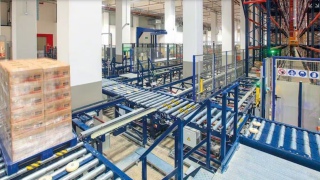Pallet Racking Capacity: A Key Factor for Efficient Storage
In the dynamic world of warehousing and logistics, efficient storage isn't just about having enough space; it's fundamentally about how effectively you utilize that space. At the heart of most modern warehouses lies the pallet racking system, a robust framework designed to maximize vertical storage. However, the true efficiency of these systems hinges on a critical, yet often underestimated, factor: pallet rack load capacity. Understanding, calculating, and adhering to these capacities is not just a matter of operational smoothness; it's a non-negotiable requirement for safety, structural integrity, and ultimately, profitability.
This article will delve into the multifaceted importance of load capacity pallet rack systems, exploring what it means, why it's vital, and the key factors that influence it. We'll also provide insights into how to optimize your racking system for maximum efficiency and safety.
What Exactly is Pallet Rack Load Capacity?
At its core, pallet rack load capacity refers to the maximum weight a specific component or an entire pallet racking system can safely support without risking structural failure, deformation, or collapse. This isn't a single, monolithic number; rather, it's a combination of different capacities that interact within the system:
-
Beam Capacity: This is the maximum weight that a pair of horizontal beams (on which pallets rest) can safely hold. Beam capacity is usually rated per pair of beams and assumes the load is evenly distributed across the beam length.
-
Upright Frame Capacity: This refers to the total weight that a single vertical upright frame can safely support. This capacity is influenced by the height of the frame, the number of beam levels attached to it, and the spacing between those levels. The higher the rack and the more levels it has, the more critical the upright frame capacity becomes, as it bears the cumulative weight of all loads above it.
-
Bay Capacity: This is the total load capacity of an entire bay (the section between two upright frames), encompassing all the beam levels within that bay. It's often limited by the upright frame capacity.
It's crucial to understand that these capacities are interdependent. Overloading a single beam can compromise the entire rack structure, even if the upright frames themselves are theoretically within their limits. Conversely, an upright frame overloaded due to too many heavily loaded levels can fail, leading to a catastrophic collapse.
Why Load Capacity Pallet Rack is Paramount
Ignoring or miscalculating load capacity pallet rack can have severe and far-reaching consequences for your business:
-
Safety of Personnel: This is, without a doubt, the most critical consideration. An overloaded or compromised racking system poses a significant risk of collapse, leading to serious injuries or even fatalities for warehouse employees. Adhering to strict load capacity guidelines is an ethical and legal obligation.
-
Prevention of Product Damage and Loss: When racking systems fail, the inventory stored on them is almost certainly damaged or destroyed. This results in significant financial losses, disrupts supply chains, and can lead to customer dissatisfaction and reputational damage.
-
Structural Integrity and Longevity of Equipment: Continuously exceeding the recommended load capacity places undue stress on the racking components. This leads to metal fatigue, bending, warping, and premature wear and tear, significantly shortening the lifespan of your expensive racking investment. Eventually, this will necessitate costly repairs or even complete replacement.
-
Operational Efficiency and Flow: An unstable or damaged racking system impedes the smooth flow of operations. Forklifts may be unable to access certain areas, or workers may hesitate to work near compromised racks. This leads to slower picking times, increased errors, and overall inefficiency.
-
Compliance with Regulations: Regulatory bodies, such as OSHA (Occupational Safety and Health Administration) in the US, have strict guidelines regarding warehouse safety and racking system usage. Non-compliance can result in hefty fines, legal liabilities, and operational shutdowns.
-
Cost Savings: While investing in the right racking with adequate capacity might seem like an upfront cost, it saves money in the long run by preventing accidents, product damage, maintenance, and potential legal fees.
Key Factors Influencing Pallet Rack Load Capacity
Several critical factors determine the load capacity of a pallet rack system:
-
Material and Grade of Steel: The type and quality of steel used in the manufacturing of the beams and uprights are fundamental. Higher-grade steel offers greater strength and durability.
-
Beam Design and Profile: The shape (profile) and thickness of the beam significantly impact its ability to resist deflection and hold weight. Beams are typically designed for specific load distributions and spans. Longer beams, for instance, generally require a deeper profile to maintain the same load capacity as shorter ones.
-
Upright Frame Design and Dimensions: The height, depth, and bracing patterns of the upright frames play a crucial role in their ability to bear vertical loads. Taller uprights, for example, tend to have lower load capacities per unit of height compared to shorter ones, due to increased buckling potential.
-
Beam Level Spacing: The vertical distance between beam levels affects the load capacity of the upright frame. Wider spacing between levels can reduce the upright frame's capacity because it increases the unsupported column length, making it more susceptible to buckling under heavy loads.
-
Type of Racking System: Different types of pallet racking (e.g., selective, drive-in, push-back, pallet flow) have varying designs and therefore different load capacity characteristics. For instance, drive-in racks are designed for high-density storage and often have robust uprights to support multiple deep loads.
-
Pallet and Load Characteristics: The weight of individual pallets and their contents is paramount. However, it's also crucial to consider the distribution of the load on the pallet itself. An unevenly loaded pallet can exert concentrated pressure, potentially exceeding the localized load capacity of a beam even if the total weight is within limits.
-
Floor Anchoring and Installation: Proper installation and anchoring of the racking system to the warehouse floor are critical for stability and ensuring that the system can safely bear its designed loads. Racks must be plumb, level, and securely anchored to prevent swaying or tipping.
-
Environmental Factors: While less common, extreme temperature fluctuations, seismic activity, or even constant vibrations from heavy machinery can impact the long-term structural integrity and thus the load capacity of the racking system.
Optimizing Your Pallet Racking for Safe and Efficient Storage
To ensure your pallet racking system operates efficiently and safely, consider the following best practices:
-
Conduct a Thorough Load Capacity Assessment: Before any installation or significant changes, engage a qualified racking professional to assess your specific storage needs. They can help calculate the required load capacity pallet rack components based on your product weights, pallet dimensions, and operational flow.
-
Consult Manufacturer's Capacity Charts: Every reputable racking manufacturer provides detailed capacity charts for their beams and uprights. These charts are your bible for safe operation. Always refer to them and ensure all personnel involved in loading and unloading understand these limits.
-
Accurate Labeling: Clearly label each beam level and/or bay with its maximum allowable load capacity. This serves as a constant visual reminder for forklift operators and warehouse staff, helping to prevent accidental overloading.
-
Even Load Distribution: Train your staff to distribute loads as evenly as possible across the beams and pallets. Avoid placing all the weight on one side of a pallet or concentrated in the middle of a beam, as this can create excessive stress points.
-
Place Heavier Loads on Lower Levels: As a general rule of thumb, store the heaviest items on the lowest beam levels. This helps to lower the center of gravity of the entire racking system, improving stability and reducing the risk of tipping.
-
Regular Inspections and Maintenance: Implement a routine inspection program for your racking system. Look for signs of damage such as bent beams, warped uprights, loose anchors, or damaged footplates. Any damage should be immediately reported and addressed by qualified personnel. Preventative maintenance prolongs the lifespan of your system and ensures ongoing safety.
-
Staff Training: Provide comprehensive training to all warehouse staff, especially forklift operators, on proper loading and unloading procedures, understanding load capacity limits, and recognizing signs of rack damage or instability.
-
Invest in Quality Racking: While cost is a factor, compromising on the quality of your pallet racking system can lead to far greater expenses down the line in terms of accidents, repairs, and lost inventory. Invest in robust, high-quality racking from reputable suppliers.
-
Consider Dynamic Storage Solutions: For operations with high throughput or specific product characteristics, consider dynamic racking systems like pallet flow or push-back racks. These systems are designed to optimize space utilization and material flow, often with specific load capacity considerations that should be carefully evaluated.
-
Factor in Seismic Considerations (if applicable): In earthquake-prone regions, local building codes and regulations will have specific requirements for seismic bracing and load capacity calculations to ensure the racking system can withstand seismic events.
Conclusion
The load capacity pallet rack is far more than just a technical specification; it's the bedrock of a safe, efficient, and productive warehouse. By understanding the intricate factors that influence these capacities, adhering to manufacturer guidelines, and implementing rigorous safety protocols, businesses can maximize their storage space, protect their inventory, and most importantly, safeguard their most valuable asset – their people. In the pursuit of efficient storage, prioritizing pallet rack load capacity is not an option; it's an imperative.

#palletracking #loadcapacity #warehouse #logistics #storage #production #safety
_0x70_d59.png)



